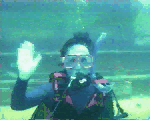 The Aquarius Undersea Laboratory
The Aquarius Undersea LaboratoryA Most Memorable Dive
 The Aquarius Undersea Laboratory
The Aquarius Undersea Laboratory
![]() We were told to go off the bow at a 90 degree angle and descend to the
sand channel then follow the sand channel to the Habitat. Due to the
depth of the dive we were restricted to a forty-five minute dive. As
we began our journey along the sand channel the vegetation changed as
we went deeper. We lost the beautiful coral and sea fans.
We were told to go off the bow at a 90 degree angle and descend to the
sand channel then follow the sand channel to the Habitat. Due to the
depth of the dive we were restricted to a forty-five minute dive. As
we began our journey along the sand channel the vegetation changed as
we went deeper. We lost the beautiful coral and sea fans.
![]()
![]() We were in the water at the depth of hugh basket
sponges. I'm a skimpy 5'2" in height, and I could have easily hid inside
one of the sponges. The sponges had to be more than five feet in height and
two or three feet in diameter - just outstanding!
We were in the water at the depth of hugh basket
sponges. I'm a skimpy 5'2" in height, and I could have easily hid inside
one of the sponges. The sponges had to be more than five feet in height and
two or three feet in diameter - just outstanding!
![]() We followed the sand channel for approximately five minutes and
then there it was! Just like a Steven Spielberg or James Bond Movie,
the Habitat just appeared out of the void. All of the divers stopped
and looked in amazement. We just couldn't believe our eyes.
We followed the sand channel for approximately five minutes and
then there it was! Just like a Steven Spielberg or James Bond Movie,
the Habitat just appeared out of the void. All of the divers stopped
and looked in amazement. We just couldn't believe our eyes.
![]() The Habitat is guarded by a pair of resident barracudas. They
checked us all out, but unlike our experience on other dives, they didn't
leave. There were many other fish, grunts mostly, swimming around. We
didn't see any of the bigger residents.
The Habitat is guarded by a pair of resident barracudas. They
checked us all out, but unlike our experience on other dives, they didn't
leave. There were many other fish, grunts mostly, swimming around. We
didn't see any of the bigger residents.
![]() The Habitat looks like the picture on the web, the only
difference being that it's yellow. There are many support and tether
cables that you have to swim under and around. The hatch is under the
platform; we looked up from the bottom (that's when my dive computer
registered 63'), but of course we didn't go in.
The Habitat looks like the picture on the web, the only
difference being that it's yellow. There are many support and tether
cables that you have to swim under and around. The hatch is under the
platform; we looked up from the bottom (that's when my dive computer
registered 63'), but of course we didn't go in.
![]()
![]() The hexagonal structure
you see in the foreground of the picture sits on a platform that's
approximately eight feet by eight feet and houses many of the underwater
instruments. I recognized a couple of different thermometers; Jude will
have to tell us in April what the other instruments are.
The hexagonal structure
you see in the foreground of the picture sits on a platform that's
approximately eight feet by eight feet and houses many of the underwater
instruments. I recognized a couple of different thermometers; Jude will
have to tell us in April what the other instruments are.
![]() You can see the
NOAA plaque on the front of the superstructure; what you can't see is the
beautiful shield that is on the other side of the cylinder. Perhaps
we'll see it on when 20/20 airs the Hugh Downs interview with Sylvia Earle,
or maybe Jude will get a picture of it when she dives in April. As
our B-31Us would say, it's way cool!
You can see the
NOAA plaque on the front of the superstructure; what you can't see is the
beautiful shield that is on the other side of the cylinder. Perhaps
we'll see it on when 20/20 airs the Hugh Downs interview with Sylvia Earle,
or maybe Jude will get a picture of it when she dives in April. As
our B-31Us would say, it's way cool!
Since there was not a mission in progress on August 12th, we were allowed to swim all around, under, over the Habitat. In fact, the only time divers are allowed in this area is between missions. When the JASON Crew is working there, it will be off limits to everyone else.
This dive is etched in my memory forever. We have the dive on video so if you would like to know more, just email me. I'll watch the video again and be ready to answer your questions and describe the minute details, like the beautiful shield.
![]()
![]()
JASON Project homepage ||
Teachers' Guide ||
Students' Corner ||
Search
Gene Carl Feldman
(gene@seawifs.gsfc.nasa.gov)
(301) 286-9428
Todd Carlo Viola, JASON Foundation for Education (todd@jason.org)
Revised: 15 December 1995